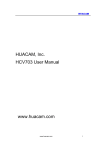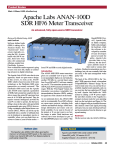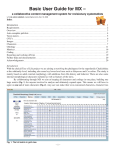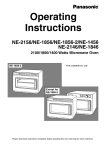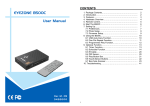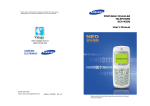Download Installation & User Manual
Transcript
By LOGENEX “Don't open your door to the unknown” Installation & User Manual rev1.0 07.2014 Logenex Innovations Inc. 6A-7500 Martin Grove Rd. Woodbridge, Ontario L4L 8S9 www.logenex.com (888) 790-5900 TELEPORT Safety Instructions These instructions are intended to assist users with the operation of the TELEPORT and also to instruct on how to avoid dangerous situations or damage to the device. Warnings: Serious injury or death may be caused if any of the warnings below are neglected. Cautions: Injury or damage to the equipment may occur if any of the following caution messages are neglected. Warnings Follow these safeguards to prevent serious injury or death. Cautions Follow these precautions to prevent potential injury or material damage. Warnings: Input voltage should meet both the SELV (Safety Extra Low Voltage) and the Limited Power Source with DC 12V according to the IEC60950-1 standard. Please refer to the technical specifications for more details. Do not use a third-party power adapter or power cord When the device is installed on the wall or ceiling, make sure that it is firmly attached. Notice Make sure that the power supply voltage is correct before using the camera. Do not drop the device or expose it to physical shock. Do not expose the device to temperatures outside the range of -10 oC to +60oC when the device is in operation. Do not expose the device to damp/wet conditions or high electromagnetism radiation. To avoid heat accumulation, make sure that your operating environment has proper ventilation. Do not attempt to open, disassemble, or modify the device A few parts (e.g. electrolytic capacitor) of the equipment shall be replaced regularly according to their average life time. The average life time varies from the differences between operating environments and usage history. Regular maintenance checks are recommended for all users. Please contact your dealer for more details. TELEPORT Contents Specifications .................................................................................................................... ..............................1 Package Contents .............................................................................................................. .............................2 Product Overview.............................................................................................................. .............................3 TELEPORT Front Panel .........................................................................................................................3 TELEPORT Basic Connection Diagram............................................................................... .................4 TELEPORT Door Station Connection Diagram................................................................................ ....5 TELEPORT DO I/O Connection Diagram.............................................................................................6 TELEPORT Relay Programming ........................................................................................................7-9 Installation Guide .......................................................................................................................................... 10 Connect your TELEPORT.................................. ................................................................................... 10 Configuring the TELEPORT via Web Browser ............................................................................. ..............11 Access TELEPORT Web Configuration Menu ...............................................................................11-15 TELEPORT ActiveX Web Page ..........................................................................................................16 TELEPORT System Page................................................................................................................17-18 TELEPORT Video & Audio Page ...................................................................................................18-19 TELEPORT Networking Page – Assign an IP to TELEPORT ............................. .........................19-20 TELEPORT Wifi Page ............................................................................................................. ...........20-21 TELEPORT DDNS Page ....................................................................................................................21 TELEPORT SIP Page ................................................................................................................... ..21-23 TELEPORT Status Page .......................................................................................................................24 TELEPORT User Management Page ...................................................................................................24 TELEPORT Maintenance Page ........................................................................................................... 25 TELEPORT SMTP Page .....................................................................................................................26 TELEPORT FTP Page ................................................................................................................... ......27 TELEPORT Alarm Event ............................................................................................................... . 28-29 TELEPORT Motion Detection ...................................................................................................... .30-31 TELEPORT System Log ......................................................................................................................31 TELEPORT Live Storage .................................................................................................................... .. 32 FAQ ..........................................................................................................................................................33-35 TELEPORT Specifications 1 of 35 TELEPORT Package Contents Items in the TELEPORT package: TELEPORT controller 12V DC power Adapter Quick installation guide Power Adapter TPC Q UICKSTARTG UIDE 2 of 35 TELEPORT Product Overview TELEPORT Front Panel 1 PWR – 12V DC power port; UL Certified. 2 NET – 10/100 Switch LAN port for connecting to Ethernet. 3 USB/WiFi – USB port for flash / hard drives. Includes hot-swap support. Or Wi-Fi dongle. 7 VIDEO – The indicator will light up 4 ON – The indicator will keep 11 DO – Digital Output (Alarm Output) green if the power is on. 5 READY – The indicator will light up green if the device is ready. 6 NET – The indicator will flash green if there is data transmission with the internet or stay solid green if there is no data transmission. 12 I/O 1 – Input or Output 1 (Default Output) 9 1 3 10 STATION – Door Station Port 13 I/O 2 – Input or Output 2 (Default Input) 14 I/O 3 – Input or Output 3 (Default Doorbell Output) 15 AUX | VID – Auxiliary Output and Analog Video Output 8 2 green when there is video input. 8 RESET - Press the Reset button for 6 seconds to perform a factory reset. 9 SD/MMC – The SD/MMC slot. 7 11 12 3 of 35 6 13 5 14 4 15 10 TELEPORT TELEPORT Basic Connection Diagram OR 4 of 35 TELEPORT Door Station Connection Diagram 5 of 35 TELEPORT DO & I/O Connection Diagram NO C NC NO C NC NO C NC NO C NC 12+ C V+ RELAY SPECIFICATIONS: Relays are rated for up to: (1 Amps at 12-24 AC or DC Volts). AUX PWR FOR 3RD PARTY DEVICE. 1AMP MAX DRAW. RELAY SPECIFICATIONS: Normally Open Relays are rated for up to: (1 Amps at 12-24 AC or DC Volts). Doorbell rewiring section Door Bell Motion/PIR/ Contact Wire is reconnected to the TeleDoorBell Front Door Transformer Disconnect switch and connect wires together Digital Output (Alarm Output) can be enabled on button press to provide a contact closure for 3rd party devices that accept a normally open or normally closed contact. Existing doorbell switch (to be removed) 6 of 35 Existing doorbell Transformer 120V AC Already connected DVR TELEPORT TELEPORT RELAY PROGRAMMING General Audio Responses • • • • ENTER COMMAND/PARAMETER – One 200mSec beep ACCEPT/ON/ENABLED – Two 200mSec beeps OFF/DISABLED – Three 200mSec beeps ERROR/REJECTED – One 1 second beep Programming section (must be in communication with door station): I/O Configuration Enter relay number, Listen for 1 beep (Incorrect relay – ERROR tone) Enter 0 for output, 1 for input and Listen for 2 beeps (Incorrect input – ERROR tone) * Default setting: I/O 1: Output Strike I/O 2: Input General I/O 3: Output Doorbell (Repeat entire sequence for additional I/O) Input Contact Select (Only active for relay configured as input) Enter relay number, Listen for 1beep (Incorrect relay – ERROR tone) Enter 0 for NO, 1 NC, Listen for 2 beeps (Incorrect input – ERROR tone) * Default setting – all I/O configured as NO (Repeat entire sequence for additional I/O) Relay Timing Enter Enter relay number, Listen for 1 beep Enter time MMSS, Listen for 2 beeps (0000=ERROR tone) (Repeat entire sequence for additional relays) * In case of error leaves time as previously saved ** Default times for relays: Relay 1: 6 sec Default: Output for strike Relay 2: 6 sec Default: General Input Relay 3: 6 sec Default: Used for Doorbell function 7 of 35 TELEPORT Factory Default Reset to factory defaults, Listen for 2 beeps * Defaults passcode back Leave Programming Mode , Listen for 2 beeps General relay control without entering Program Mode: Relay Control Close relay 1 for programmed time 2 beeps Close relay 2 for programmed time 2 beeps Close relay 3 for programmed time 2 beeps * Programmed times can be changed in the programming section by command . ** If relay is configured as an input – ERROR tone. 8 of 35 TELEPORT 9 of 35 TELEPORT Installation Guide Connect your TELEPORT Using the Power adapter as power supply Connect the door station to the Remote/Station port on the TELEPORT controller. Connect an RJ 45 cable to the NETWORK port of the TELEPORT Connect the other end of the RJ 45 cable to your network or PC directly Connect the power supply to the DC 12V power jack on the back of the TELEPORT Connect the other end of the power supply to a wall outlet. The POWER indicator will light green The NETWORK indicator will light green within 5 seconds to indicate that a connection to the internet has been established. The TELEPORT is ready when the READY indicator lights up green. The VIDEO indicator will light up when the door station is connected. NOTE: If you are going to connect the device to a hub/switch/router, please use a straight-through cable. A cross over cable should be used if you are going to connect the device directly to a PC. 10 of 35 TELEPORT Configuring the TELEPORT via Web Browser Step 1: Connect your PC and the TPC to the same network. Step 2: Run the TELEPORT search tool (TP_search.exe) 11 of 35 TELEPORT Step 3: .Click the appropriate device on the table. Confirm by MAC address. Step 4: Configure the desired network setting below once your device has been highlighted. The network can be configured to use a DCHP or static IP address. DCHP is selected by default Step 5: To configure static settings uncheck the Use DCHP box, configure your custom settings and click the modify IP button. Step 6: You can confirm your changes by clicking the search button again. The device should show up with your new changes. Again confirm by MAC address. 12 of 35 TELEPORT Step 7: Install the Video Plug-in for IE, Firefox and Chrome. Step 8: .Access the web interface of the TELEPORT, either - by typing . IP address or double clicking the device line from the search the .tool. The live video from your TELEPORT will appear. Step 9: Click the configuration link in the top bar to configure the TELEPORT. 13 of 35 TELEPORT Step 10: You will be promted for a username and password. The default username is admin and the password must be obtained from. your dealer login profile. 14 of 35 TELEPORT Step 11: Click the device info icon for you controller.( Always at top of list) The admin password will then be displayed at the bottom of the child window under the direct camera access section. 15 of 35 TELEPORT 8 9 10 11 1 2 3 4 5 6 7 Figure3: ActiveX web page of TELEPORT Items on TELEPORT ActiveX Home Page 1 2 Play Capture Plays/Stops the video. Captures the image displayed and saves it to C:\GS_Capture 3 Record 4 5 6 7 Sound Off/On Talk Playback Config Records the video and saves it to C:\GS_Record (default directory). Toggles the sound On or Off. Establishes two-way audio. Replays the saved video. Configures the Save Location for captured images and recorded videos. 8 9 10 11 BRIGHTNESS CONTRAST SATURATION View Size Adjusts the image brightness. Adjusts the image contrast. Adjusts the image saturation. Resize the image to fit into the window panel in the home scream. 16 of 35 TELEPORT TELEPORT System Page This page allows you to configure the system settings on TELEPORT. Current System Time - displays the current date and time (24h clock). Set the System Time Update via NTP Server - the camera will obtain the time from an NTP server Specify the NTP server's IP address or host name. And you can select your time zone from the drop-down list or define your own time zone setting. NOTE: If using a host name for the NTP server, a DNS server must be configured under Basic Settings -> Networking. Synchronize with Local Computer - sets the time from the clock on your computer. Set the Time Manually - this option allows you to manually set the time and date. OSD Date Format - set the format of date on OSD Device Name Setting -This field lets you configure the name of the TELEPORT. 17 of 35 TELEPORT DI and DO - Digital input and digital output Normal open: the circuit is by default open unless an event triggers the device to close the circuit. Normal close: the circuit is by default closed unless and event triggers the device to open the circuit NOTE: Do not change the Digital Input Setting, this is pre-configured for the door station button press. TELEPORT Video & Audio Page On Screen Display (OSD) Settings OSD Time/ Text – The time stamp and channel name displayed on the screen. Video Settings Preferred Video Codec – The TELEPORT supports the H.264 video codec. Resolution – The higher the resolution is, the better the video quality is, and higher bandwidth is required. Low ----------------------Æ High Resolution QCIF CIF 2CIF D1 Bit Rate – The number of bits that are conveyed or processed per unit of time. Maximum Frame Rate – The video frame rate is adjustable based on network conditions. Increasing the frame rate will increase the amount of data significantly therefore consuming more bandwidth. Video will be impaired due to packet loss when there is insufficient bandwidth. Bit Rate Control – Variable Bit rate (VBR) 18 of 35 TELEPORT and Constant Bit Rate ( CBR). Variable Bit Rate - If VBR is selected, the codec varies the amount of output data per time segment. VBR produces a better quality-to-space ratio. The bits available are used to enable more flexibly and encode sound or video data more accurately, with fewer bits used in less demanding passages and more bits used in difficult-to-encode passages. Constant Bit Rate - If CBR is selected, the codec’s output data is constant regardless of the input data. The output bit rate is defined in “Bit rate”. CBR is useful for streaming multimedia content on limited capacity channels. It is easier to calculate required bandwidth as well as the required storage space using CBR. Image Quality – If ‘Bit Rate Control’ is set to “ VBR”, “Image quality” needs to be configured. The better the video quality is, the higher the bit rate will be. I-frame Interval – While streaming video over a network, compression technologies are used to show the incremental difference between each frame. I-frames are used to help keep the video looking normal. When intervals are shorter, the video quality is higher but uses more bandwidth. NOTE: The users might need to configure the Primary Stream and Secondary Stream properly. Sometimes, the user might like to watch the live video stream from the web GUI in low resolution mode while recording a copy via an NVR in high resolution due to the limitation of internet bandwidth. In this case, for example, primary stream can be configured to have better resolution, and then the users can use primary stream to record while watching secondary video streams. Audio Settings Preferred Audio Codec – The TELEPORT supports up to 3 different Vocoder types, a-law (PCMA), u-law (PCMU) and G.726. The audio can also be turned off by switching the setting to “Disabled” Audio Compression – Audio compression is a form of data compression designed to reduce the size of audio files. Usually, the higher the audio compression is, the better the audio quality is. TELEPORT Networking Page – Assign an IP to TELEPORT TELEPORT supports IP version 4. The IP address can set automatically via DHCP, or a static IP address can be set manually. To make TELEPORT work properly, the user needs to set the DNS configuration properly. For security purposes, the user can also assign the TELEPORT an HTTP Port other than 80. 19 of 35 TELEPORT IP Address Configuration The TELEPORT operates in two modes: Dynamically Assigned via DHCP – all the field values for the Static IP mode are not used. The TELEPORT acquires its IP address from the first DHCP server it discovers on its LAN. Statically Configured as – configures all of the following fields: IP address, Subnet Mask, Default Gateway IP address, DNS Server 1 (primary), DNS Server 2 (secondary). These fields are set to zero by default. Static IP addresses are recommended for the TELEPORT DNS Configuration There are two methods of DNS configuration on the TELEPORT: 1. The TELEPORT can obtain the DNS server automatically 2. Users can configure their own preferred DNS server HTTP Port The TELEPORT supports user configured http ports. If the HTTP port is changed, the port number is needed to access the web GUI, for instance: http://192.168.1.168:8080. NOTE: If the HTTP Port is 80, when you add this device to an NVR, the RTSP port is 554. If the HTTP Port is changed, when you add this device to GSurf or GS_ NVR, please make sure the RTSP port number equals HTTP Port plus 2000. TELEPORT Wifi Page TELEPORT supports WIFI via wireless dongles, Enable Wifi – Checked to enable Wifi SSID – Click on Scan to view available network. 20 of 35 TELEPORT Choose a network and Click on Select to confirm. Security Mode – Choose associated Security mode. TELEPORT DDNS Page Dynamic DNS provides devices that have a variable, often changing IP address with a well known hostname resolvable by network applications through standard DNS queries. Set up DDNS 1. Apply for a domain name from your service provider. 2. Login to the web configuration page, click Basic Settings > DDNS. 3. Enter the required information DDNS Active – If you want to use DDNS, please set this field to “Enabled” . DDNSISPType – Select your DDNS ISP Type. Self-Define DDNS Address – Self-define the DDNS server instead of using DDNS ISP Type. SiteName – The DDNS name for your device. DDNS Account/ DDNS Password – The account and password from the DDNS Provider. STUN Server – If the device is behind a router, a STUN server is needed to help penetrate the NAT. 4. Click Save to save the changes. You might need to reboot the device to apply all the changes. TELEPORT SIP Page The TELEPORT has the ability to receive phone calls and make phone calls when an alarm event is triggered through motion detection or alarm input. Register the TELEPORT to a SIP server to enable the product to make and receive phone calls. 21 of 35 TELEPORT To receive phone calls from the TELEPORT, the user needs to configure the Phone List properly. NOTE: The Group number from your TELEPORT account should be entered here. Register TELEPORT to a SIP Server 1. From the TELEPORT home page, click Basic Settings > SIP. 2. Go to SIP Settings Tab. 3. General Phone Settings. Registered – The field shows the registration status of the account with the SIP server. Unregister On Reboot – If it’s checked, the SIP user’s registration information will be cleared from the server when the phone reboots. 4. Enter the required information. Account Name – The field configures the SIP account name. SIP Server – The SIP Server’s IP address or Domain name provided by your service provider. Outbound Proxy – The IP address or Domain name of the Outbound Proxy, Media Gateway, or Session Border Controller. Used for firewall or NAT penetration in different network environments. If the system detects a symmetric NAT, STUN will not work. ONLY outbound proxies can provide a solution for a symmetric NAT. SIP User ID – User account information provided by your service provider (ITSP); this is either an actual phone number or is formatted like one. Authenticate ID – The SIP service subscriber’s Authenticate ID used for authentication. It can be identical to or different from the SIP User ID. Authenticate Password – The SIP service subscriber’s account password for the GXV to register to the SIP server of the ITSP. STUN Server – If the device is behind a router, a STUN server is needed to help penetrate the NAT. Stream – To choose between Primary and Secondary stream. Preferred Vocoder – To choose different Vocoder type. Registration Expiration – This parameter allows users to specify the time frequency (in minutes) in which the GXV refreshes its registration with the specified registrar. The default interval is 60 minutes. Local SIP Port – This parameter defines the local SIP port u sed to listen and transmit. 22 of 35 TELEPORT 5. The default value is 5060. Local RTP Port – This parameter defines the local RTP- RTCP port pair that is used to listen and transmit. The default value is 5004. Click Save to save all the changes. You need to restart the device to apply all changes. SIP Open Door Settings– Only applicable on TELEPORT . Enable SIP open door – This will close the DO connections in the back to close the circuit connected to it. Key to open the door – DTMF key to close the circuit. Digits 0-9 only. Delay lock time (seconds) – This is the time in seconds that the circuit will remain closed when this function is triggered Configure Phone List Page To make sure the TELEPORT can make phone calls to the number you preferred when alarm is triggered. You need to add number to the phone list. Steps to add phone number: 1. From the TELEPORT home page, click Basic Settings > SIP. 2. Go to Phone List Tab. 3. Enter the Group number and name, click Add a Number to save all the changes. 4. Numbers added to the system will be listed in this page. Available phone numbers NOTE: With current firmware, only the first phone number in the list will be called when an alarm is triggered. 23 of 35 TELEPORT TELEPORT Status Page System Statistics System Statistics lists hardware and software information, for example, the part number, the software version, about the TELEPORT. Hardware Version – This field contains the product’s hardware information. Part Number – This field contains the product part number information. Bootloader Version – Bootloader code version number. Core Version – Core code version number. Base Version – Base code version number. Firmware Version – Firmware code version number. System Up Time Since – This field shows the system up time since the last reboot. Network Status MAC Address – The device ID, in HEXADECIMAL format. LAN IP Address – This field shows the LAN IP address of the TELEPORT. LAN Subnet Mask – This field shows the LAN subnet mask of the TELEPORT. LAN Default Gateway – This field shows the LAN default gateway of the TELEPORT. DDNS Status – This field shows the status of DDNS. TELEPORT User Management Page All current users will be list in the User List section of this page. You can also add and remove users here. Existing User Name –The field lists all of the current users. You can insert or remove users from the list by click on the Add or Update or Delete button. User Name / Password – The user name and password 24 of 35 TELEPORT required to login. Privilege – The privilege for the user to access to configuration page. Allow Anonymous Login – If ‘Allow Anonymous Login’ is set to Yes, no user name and password are required to login to the TELEPORT web configuration pages. If you login anonymously, you will not be able to change any settings. TELEPORT Maintenance Page Server Maintenance Restart – Click this button to restart the TELEPORT . Restore – Click this button to perform a partial factory reset (The IP address will not be cleared) . 25 of 35 TELEPORT TELEPORT SMTP Page The SMTP server is used to send out emails when an alarm event or motion detection is triggered. The SMTP settings must be configured to make sure the alarm email is sent out properly. SMTP Server Settings Enable SMTP – Checked to enable SMTP SMTP Server – The IP or hostname of the SMTP server, for example, smtp.gmail.com. SMTP Server Port – The port of the SMTP server. The TELEPORT supports port 25 and SSL port 465, which is for SMTP with an encrypted connection. From E-Mail Address – The email address that sends out the alarm email(s). To E-Mail Address – The email addresses that the alarm email(s) will be sent to. You can have up to 3 emails configured. User Name/ Password – The user name and password required to log in to your SMTP server, for example, [email protected]/123. SSL – Checked if the SMTP server requires a secure connection. Test Email Account Settings – Click the Test button to send a test email from the From E-Mail to the To E-Mail to make sure that SMTP is configured properly. If the receiver can get the test email, then the SMTP settings are ready to go. 26 of 35 TELEPORT TELEPORT FTP Page The FTP server is used to store video files if you configure the TELEPORT to record video and upload it to the FTP server when an alarm event or motion detection is triggered. FTP Settings Enable FTP – The default setting is “No,” if you want the TELEPORT to upload the recorded video to the FTP server when an alarm is triggered, set this field to “Yes.” FTP Server – The IP address or hostname of the SMTP server, ie. ftp.myserver.com. FTP Server Port – The port that your FTP server is using. User Name / Password – The user name and password required to log into your FTP server Path – The directory in the FTP server where recorded video will be uploaded. Test FTP Account Settings – Click the Test button to upload a sample file to make sure that FTP is properly configured. 27 of 35 TELEPORT TELEPORT Alarm Event The TELEPORT supports alarm inputs, for example, infrared detector, smoke detector and so on. Follow the steps to make Alarm Input work: 1. Connect alarm input equipment to the TELEPORT. 2. Set up the alarm event time schedule. 3. Configure the alarm actions which you would like the TELEPORT to take when alarm is triggered. How Alarm Input and Alarm Output Work Alarm-in is the alarm input port; users are able to connect sensors such as infrared sensor, smoke sensor or light sensor to it. The detectable signal voltage range for alarm-in is from 1.8V to 15 V NOTE: Please do not connect a device that has a signal voltage that is higher than 15V, this will damage the IP camera. Internally, the Alarm-out uses relays as a switch (30VAC/2A); users can connect devices such as alarm siren or alert light to this port. Under normal circumstances, the circuit is open. When there is an alarm event, the TELEPORT will close the circuit to trigger the alarm. Connect Alarm Input Equipment to the TELEPORT See Page 9. Set up Alarm Actions An alarm action is what the TELEPORT is going to do when an alarm is triggered during the defined time period – the time schedule. The TELEPORT allows multiple alarm actions. Record Video – If this option is selected, the TELEPORT will record the video when an alarm is triggered. You can enter the length of the video recording (in seconds). You can also choose the storage method for video files: SD card, USB Flash drive, or USB hard drive. Voice Alarm to SIP Phone – If this option is selected, the TELEPORT will make calls to the number listed in the Phone List page using the configured SIP account when an alarm is triggered. To use this function, the settings in SIP page must be configured properly. Alarm Output – If this option is selected, the alarm will output via the configured method/equipment when it is triggered. Upload to Alarm Center – This option is an integrated feature with the TELEPORT cloud service. If this option is checked, the TELEPORT will report the alarm event. 28 of 35 TELEPORT Record Video and Upload to FTP server – If this option is selected, the TELEPORTwill record the video and upload it to the FTP server when an alarm is triggered. You must check Record Video and configure the FTP page properly to use this feature. Email JPEG and Store it to USB drive or SD card– If this option is selected, the TELEPORT will capture the image and store it to connected live storage device when an alarm is triggered. Set up Alarm Event Time Schedule This section allows you to configure the time during which the TELEPORT will monitor the Alarm Input. The TELEPORT can not only monitor your settings but can also take actions when the alarm is triggered. Dropdown list for date Available schedules time To add a schedule, select the date from the dropdown list, Start Time and End time and Click Add to add a new time schedule. To delete a schedule, check the schedule you would like to remove and click Delete. How to connect an Alarm Output Equipment to TELEPORT See Page 9. 29 of 35 TELEPORT TELEPORT Motion Detection The TELEPORT supports Motion Detection. To utilize this feature, please follow the below steps: 1. Setup the motion detection monitored area. 2. Configure the motion detection time schedule. 3. Configure alarm action properly. Setup Motion Detection Monitored Area Enable Motion Detection – If this option is selected, motion detection will be enabled. If something/somebody moves in the motion detection region, an alarm will be triggered. Show Motion Detection Regions – If this option is selected, the motion detection regions will be displayed on the screen with a white border. The white border for Motion Detection Regions NOTE: If Upload to Alarm center is checked for Alarm Actions, the white border will flash red when a motion detection alarm is triggered. To Edit a Monitored Area 1. In the Select a Region dropdown list, select the region ID. 2. Click Edit. 3. Click on the video, drag and draw you preferred area. 4. Set the Sensitivity. Click the Save button to save the sensitivity. NOTE: The Sensitivity value varies from 0 to 100. The larger the value is, the higher the sensitivity. 5. Click Save to save the settings. Button to save sensitivity only To Remove a Monitored Area 1. In the Select a Region dropdown list, select the region you would like to remove. 2. Click Remove. 3. Click Save to save the changes. 30 of 35 TELEPORT Configure Motion Detection Alarm Actions An alarm action is what the TELEPORT during the defined time period – the time schedule. The TELEPORT allows multiple alarm actions. is going to do when an alarm is triggered Configure Motion Detection Time Schedule This section allows you to configure the time during which the TELEPORT will monitor the motion detection. The TELEPORT not only can monitor your settings but also can take actions when the alarm is triggered. Monitored region Dropdown list for date Available schedules time TELEPORT System Log This page is used to set up the system log server path and system log level. Once they are correctly configured, the device will send out system log messages to the system log server, which will help perform troubleshooting. Syslog Server – The IP address or URL of System log server. Syslog Level – Select the device to report the log level. Default is None. The level is one of Debug, Info, Warning or Error. 31 of 35 TELEPORT TELEPORT Live Storage This page displays detailed information of the live storage devices connected to the TELEPORT such as video and image files. You can view, download or delete the stored files. Storage Information – This section displays the type, capacity, used space, free space and usage percentage of the connected USB drive or SD card. JPEG List – This section displays the name, source storage and size of the image files on the connected storage devices. You can view, download or delete the stored files. Video List – This section displays the name, source storage and size of the video files on the connected storage devices. You can view, download or delete the stored files. 32 of 35 TELEPORT TELEPORT Installation FAQ 1. What is the default IP address of TELEPORT? Prior to firmware version 1.0.3.9, the IP address of TELEPORT/ 3504/ 3601/ 3611 is 192.168.1.168 at the factory default settings. You can perform a factory reset by pressing the RESET button on the device for 7 seconds. Starting from firmware version 1.0.3.9, the default IP configuration is DHCP. 2. Why can I not view the live video stream in Microsoft Internet Explorer? Please check whether the IE add-on is installed correctly. Obtain the plug-in from http://logenex.com/productpdf/TELEPORT/chrome_firefox_plugine_1.0.0.7.exe 4. Why can’t I access the TELEPORT web configuration interface? Q 1: Is your internet service down? A 1: Connect a PC to the internet to test the connection. Q 2: Are the PC and the device in different subnets? A 2: Check the subnet mask and default gateway of the device and PC. Q 3: Is there a conflict with another IP address? A 3: Try to change the IP address of the device. Q 4: Has the HTTP port been changed? A 4: Contact the administrator of the device for more information. 5. The TELEPORT web configuration page is not displayed correctly in Internet Explorer 8? In IE8, Compatibility View might need to be enabled for the TELEPORT web configuration page to load properly. To enable compatibility view, open IE8, click Tools>Compatibility View Setting, and add the TELEPORT web configuration pages to the Compatibility View. 6. How do you watch secondary video stream? Login to the home page of the TELEPORT/ 3504/ 3601 web GUI, click Play to watch the video stream. To watch a secondary video stream, right click on the video, and select Secondary Stream on the pop-up menu. Try reinstalling the Grandstream Viewer add-on for IE if you cannot see the video stream. 33 of 35 TELEPORT 7. What is DDNS? Is it important for IP surveillance product to have DDNS support? DDNS is an acronym for Dynamic Domain Name Service. It is important to choose an IP network camera that has DDNS support for dynamic IP addresses. Chances are that the network has a dynamic IP address (which changes with every log on). A DDNS service makes sure that the camera’s IP address always matches up to the current server address. DDNS also allows for a website to be linked to the IP camera that is constantly updated with the correct information and has a reliable feed. 8. Why is Windows Media Player unable to play the recorded videos files? The TELEPORT /3601/3504 all use the H.264 video codec. Windows Media Player may lack the proper H.264 decoder to play the recorded video. Please download the Microsoft FFDShow H.264 decoder from http://sourceforge.net/projects/ffdshow-tryout/ and install it. 9. Why doesn’t the IP address of the device reset when I click the “Restore” button on the Maintenance page? The TELEPORT could be installed in areas that are not easy to access. For example, it could be installed on the roof of a building or the ceiling of an office. This makes it difficult to reinstall the device, therefore the “Restore” function will not clear the IP address. Press the RESET button on the device for at least 6 seconds until you hear a beep to perform a factory reset of all parameters (including the IP address). 10. Why can’t the live video stream be view ed using an NVR after changing the HTTP Port of the device? Make sure that the RTSP port of the device is set to 2000 plus the HTTP Port number. For example, if the HTTP port is 88, then the RTSP port of the device that you configured on your NVR should be 2088. 11. Some notes on using SD cards / USB drives. 1. The TELEPORT only supports FAT32 formatted USB drives 2. The TELEPORT supports SD and SDHC 3. It takes 10-15 seconds to read SDHC and USB drives with large memory capacities. Please wait 15 seconds to unplug the SD/ USB drive after you plug them into the device. 4. If there are many files (ie. 1800 or more image batch files) on the SD/ USB drive, it can take up to 5 minutes to read them. Please do not refresh the web interface at this time as the TELEPORT will restart reading the SD /USB drive. We are currently working on a fix for this issue. 34 of 35 TELEPORT 6. Port forwarding Two ports must be forwarded on your router to watch video from a TELEPORT that is located on a private network from a PC in a public network. The web port (HTTP) and the RTSP port. Please make note that the RTSP port number changes according to the web port. If the web port is 80, then the RTSP port is 554. If the web port is not 80, then the RTSP port equals the web port +2000. For example, if the web port is 88, then the RTSP port will be 2088. 35 of 35 NOTES “Don't open your door to the unknown” rev1.0 07.2014 Logenex Innovations Inc. 6A-7500 Martin Grove Rd. Woodbridge, Ontario L4L 8S9 www.logenex.com (888) 790-5900









































